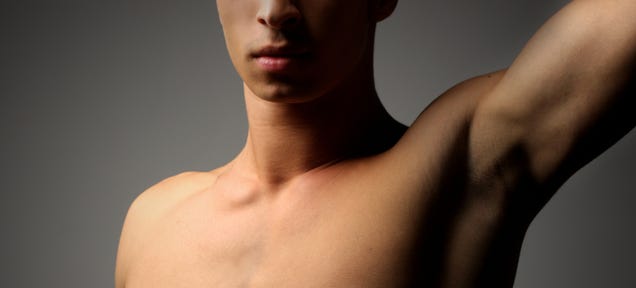Why do armpits smell so bad? Well, those millions of bacteria have to live somewhere.
Sweat and Odor
There are two universally-accepted types of sweat glands.
Eccrine Glands
The most abundant of the sweat glands, eccrine are found on most of the body and
secrete a sweat that is: "
A sterile, dilute electrolyte solution that contains primarily sodium chloride (NaCl), potassium and bicarbonate . . . ."
Most of us are familiar with
the reason our eccrine glands produce sweat: "
Continuous
secretion . . . provides a mechanism for thermoregulation via
evaporative heat loss [and] maintenance of electrolyte balance . . . ."
Apocrine Glands
This
type of gland is found in hairy places on the body, such as the armpits
and between the legs. Near the skin's surface, inside the hair
follicle,
apocrine glands secrete: "
A milky fluid that most commonly [occurs] when you're under emotional stress. This fluid is odorless . . . ."
Despite its
innate lack of smell: "
[Apocrine
sweat] is rich in precursors of odoriferous substances (cholesterol,
triglycerides, fatty acids, cholesterol esters, squalene). It also
contains androgens, carbohydrates, ammonia and ferric iron."
In addition, this gland produces pheromones, the "
chemical signals that instigate behavioral responses (e.g. sexual attraction)."
Armpit Funk
At any given moment, there are
100,000,000,000,000 (one hundred trillion) bacteria living on your body. So, of course, a few are going to wander down to the smorgasbord that is your armpit, itself "
home to one million bacteria per square centimeter."
Dining on the aforementioned precursors, notable axillary stinkers include
Corynebacterium spp., Staphylococcus spp., Micrococcus spp. and
Propionbacterium spp., and, depending on their food of choice, any of a
range of offensive odors can be produced: "
The
sulfur-containing molecules are the worst, giving armpits their
characteristic nauseating, onion-like smell. . . [while others produce]
a cumin spice-like odor . . . . Two possible pheromones, androstenol,
which is musky, and androstenone . . . [may also contribute. Finally,]
isovaleric acid has a cheesy, sweaty foot smell, as does propionic
acid."
A Wealth of Information
Researchers have determined that
some mammals are born with distinct bouquets, organized into odortypes: "
An
individual's odortype is determined in part by genes in [the] . . .
major histocompatibility complex (MHC), which plays a role in the immune
system . . . ."
Acting as "
olfactory nametags,"
an individual's unique fragrance helps others identify him, and
apparently, it cannot be changed, no matter how much garlic and cumin he
eats: "
In behavioral tests, 'sensor' mice were trained to use their
sense of smell to choose between pairs of test mice that differed in
MHC genes, diet or both. . . . The results . . . indicate that
genetically determined odortypes persisted regardless of what the mice
ate, even though dietary changes did strongly influence the odor
profiles of individual mice. Both the sensor mice and chemical analysis
could still detect the underlying odortypes."
The study's
authors concluded that: "
If
this can be shown to be the case for humans, it opens the possibility
that devices can be developed to detect individual odorprints in
humans."
Later research explored the extent to which disease
in a body gives off an aroma by taking advantage of the olfactory
virtuosity of our
canine friends: "
A
Belgian Malinois shepherd was trained . . . to scent and recognize
urine of people having PCa [prostate cancer] . . . After a learning
phase and a training period of 24 mo, the dog's ability to discriminate
PCa and control urine was tested in a double-blind procedure. . . . .
The dog . . . correctly designated the cancer samples in 30 of 33 cases.
Of the three cases wrongly classified as cancer, one patient was
rebiopsied and a PCa was diagnosed."
It Could Be Worse
Some people suffer from a condition where they're body odor smells like rotting fish. Called
trimethylaminuria, people with this disorder
cannot break down trimethylamine: "
Which
is found in eggs, liver, legumes and some grains. [Commonly] it is
broken down by bacteria [and] . . . is normally oxidized in the liver to
odourless TMAO [trimethylamine], which is excreted from the body."
The compound smells like fish because it is commonly found in them. It is "
believed… it… increases osmotic concentration and thus depress the freezing point of body fluids."
In people who suffer from
trimethylaminuria, the smell is emitted in their "
sweat, urine and breath," a condition often leading to social isolation and derision, such as the much-reviled Caliban of Shakespeare's
The Tempest:
"What have we here? a man or a fish? dead or alive? A fish: he smells
like a fish; a very ancient and fish-like smell . . . . A strange fish!"
Trimethylaminuria
is a rare inherited condition that only occurs in people who inherited
two copies of the defective gene, one each from their mother and father.
It is estimated that 1 in 10,000 suffers from this syndrome.
If you liked this article, you might also enjoy:
Bonus Fact:
- A
third type of sweat gland, called apoeccrine, has been suggested by
some scientists, although a 2007 study that examined axillary (armpit)
skin failed to find evidence of it "either by histology or by immunofluorescence."








